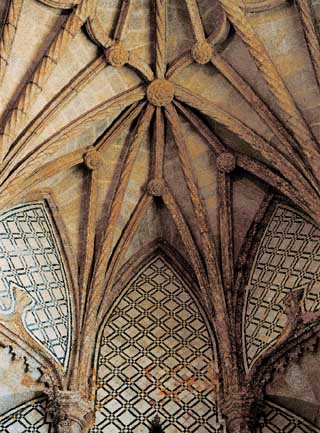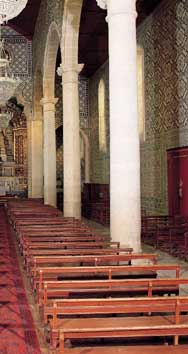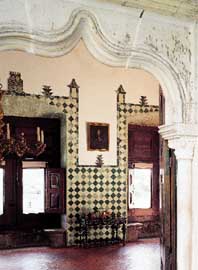|
|
|
|
|
|
|
|
|
|
|
|
|
|
 |
|
|
|
|
|
|
|
|
|
|
|
|
|
|
|
|
The XVII Century
Repetitite tiles
|
 lthough the taste for covering surfaces with monumental ceramic displays was by now well established in Portugal, commissioning large and unique compositions individually adapted to each space was an expensive affair, and so repetitive patterns became more common. lthough the taste for covering surfaces with monumental ceramic displays was by now well established in Portugal, commissioning large and unique compositions individually adapted to each space was an expensive affair, and so repetitive patterns became more common.
Chequered designs became popular at the end of the XVI and the beginning of the XVII centuries. They were composed of plain coloured tiles, alternated in such a way as to create decorative patterns on walls. However, although the tiles themselves were cheap, laying the chequered patterns was slow and complex and therefore expensive, a factor which gradually led to their disappearance.
Standard-pattern tiles, which were produced in large quantities and were easy to apply, then began to appear. At first they were supplied in repetitive modules of 232, but the modules gradually increased in size over the course of the XVII century until they finally reached units of 12312, thus creating rhythmically powerful diagonal patterns.
All these chequered and standard-pattern tiles needed borders and bars around them to ensure their proper integration into the contours and architectural ramifications of the buildings.
|
|
|
|
 |
|
|
|
 |
|
Jesus Church,
Setúbal, late XVI century.
photograph: Nicolas Lemonnier
|
|
|
|
|
|
|
 |
|
|
|
|
|
|
|
|
|
|
|
|
|
|
|
Marvila Church,
Santarém, 1617.
photograph: Paulo Cintra e Laura Castro Caldas
|
|
|
|
 |
|
|
|
|
|
|
|
 |
|
|
|
|
"Diamond Tip",
São Roque Church,
Lisbon, late XVI century.
hotograph: Nicolas Lemonnier
|
|
|
|
|
|
Igreja de Marvila,
Santarém, 1635 · 1639.
foto: Paulo Cintra e Laura Castro Caldas
|
|
|
|
|
|
|
|
|
|
|
|
|
|
|
|
|
|
The Swan Room,
Sintra Palace National, Sintra, c. 1500.
photograph: Nicolas Lemonnier
|
|
|
|
|
|
|
© Instituto Camões, 2000
|
|
|
|
|
|